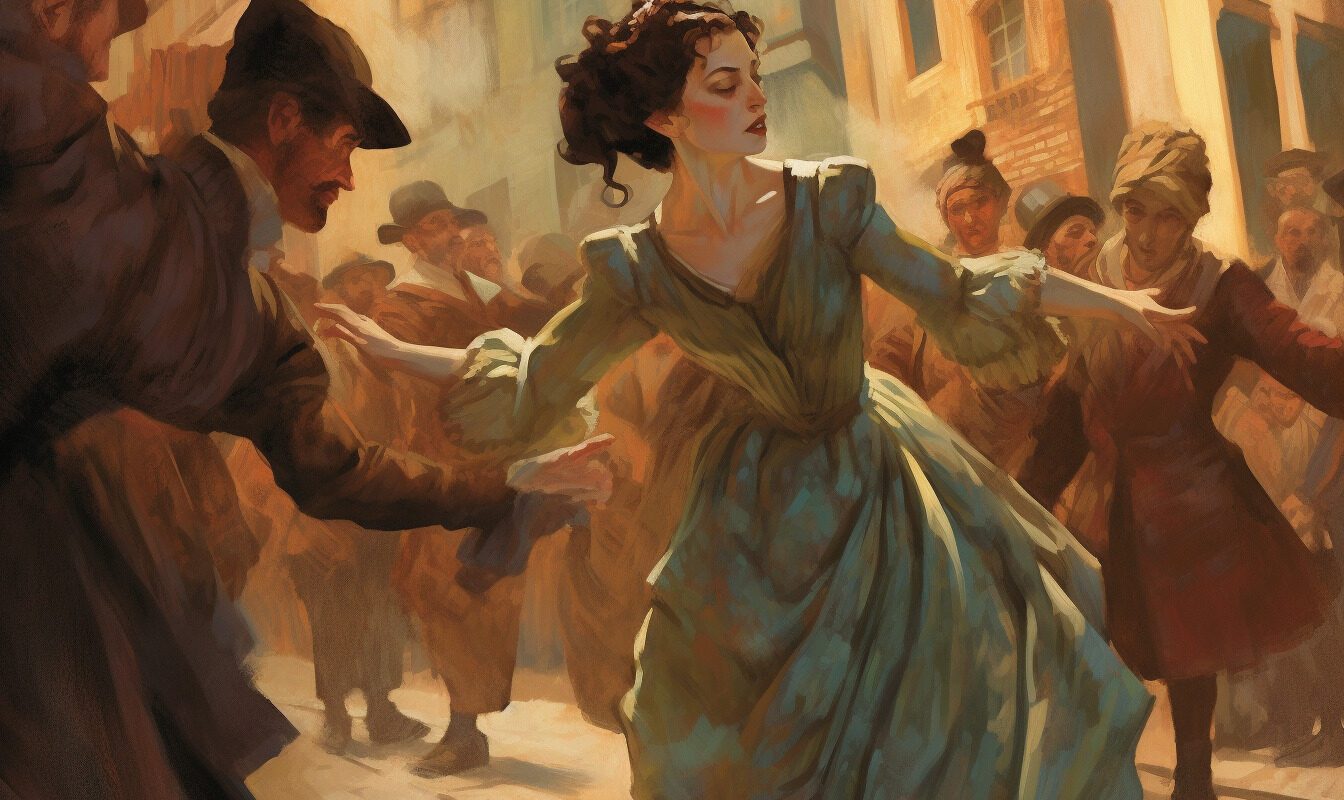The transformation of Katherine in ‘The Taming of the Shrew’ from an assertive and outspoken woman to a subdued wife is often presented as a positive one. This perspective is a product of the societal norms of Shakespeare’s era, when women were expected to be docile and subservient. However, in a modern reading, we can see this as a process of suppressing Katherine’s free spirit.
Instead of viewing Katherine as a ‘shrew’ that needs ‘taming’, we could interpret her as a woman pushing back against the restrictions of her society. The treatment of Katherine by Petruchio, with methods that are both absurd and cruel by modern standards, can be seen as a critique of these backward societal norms. The extreme lengths Petruchio goes to ‘tame’ Katherine highlight the harsh methods society employed to enforce compliance among women.
A modern reinterpretation should retain Katherine’s assertive spirit throughout the play. Instead of ‘taming’, she should be seen as navigating the societal labyrinth, adopting certain behaviors not as a sign of defeat, but as a strategic play to maintain her personal freedom. Thus, ‘The Taming of the Shrew’ can be redefined to celebrate women’s audacity and individuality, rather than condemn it.
The Transformation of Katherine
William Shakespeare’s ‘The Taming of the Shrew’ opens with a fiery and assertive Katherine, who rejects societal expectations of female obedience and docility. Her first interaction with Petruchio, her eventual husband, is filled with quick-witted retorts and vehement rejections of his advances, illustrating her strong personality. A notable line, “If I be waspish, best beware my sting”, encapsulates Katherine’s willingness to defy patriarchal norms and fight back (Act 2, Scene 1).
However, this strength is deemed problematic within the context of the play. Baptista, her father, is desperate to find her a suitor, but her sharp tongue and autonomous nature deter most men. It isn’t until Petruchio agrees to marry her, with a primary intent to ‘tame’ her, that her fate is sealed. Katherine becomes an object to be manipulated and controlled, a ‘shrew’ that needs ‘taming’.
The term ‘shrew’ is imbued with derogatory connotations, highlighting the play’s sexist undertones. In a man, Katherine’s resistance would likely be praised, yet in a woman, it makes her an outcast. The gendered double standards are rife within the play, presenting Katherine as a problem that requires a solution, underpinning the inherent misogyny of Elizabethan society.
The Critique of Societal Norms
Petruchio’s approach to ‘taming’ Katherine unfolds as a systematic and deliberate process designed to break her spirit. The methods employed range from outright lies and deception to physical and psychological deprivation. In Act 4, Scene 1, Petruchio deliberately starves Katherine, under the guise of concern for her well-being, saying, “It is burnt; and so is all the meat. What dogs are these! Where is the rascal cook?”. His manipulation continues with depriving her of sleep, under the pretense of her comfort.
Yet, the transformation process isn’t only about what Petruchio does to Katherine. It’s equally about the societal reinforcement of these norms. Baptista, her father, and the other characters within the play express little concern for Katherine’s well-being, showing complacency and even complicity in the process. Baptista’s nonchalant agreement to Petruchio’s plan signifies the societal approval of suppressing women’s autonomy.
The transformation of Katherine is revealed in her final monologue, a lengthy speech where she endorses female subservience. The speech, fraught with endorsement of male superiority, is a stark departure from her earlier defiance, signaling a complete character transformation. She implores the other women, “Thy husband is thy lord, thy life, thy keeper… one that cares for thee”, suggesting that women should happily submit to their husbands (Act 5, Scene 2).
In viewing this speech, it’s essential to remember that Katherine’s endorsement of such beliefs comes only after intense manipulation and coercion. Her conformity, then, becomes less a natural change of heart and more a survival mechanism within the confines of the society she inhabits. Thus, ‘The Taming of the Shrew’ serves as an alarming demonstration of how societal norms can suffocate female individuality.
The Modern Reinterpretation of Katherine
The gender inequality prevalent in ‘The Taming of the Shrew’ extends beyond Katherine’s personal journey, seeping into the dynamics of other characters as well. Take, for example, the character of Bianca. While initially perceived as the more desirable sister due to her outward obedience and grace, closer inspection reveals troubling aspects to her character.
The men in the play treat Bianca as a prize to be won, a testament to their masculinity and status. In Act 2, Scene 1, we see a blatant display of this objectification where Gremio and Tranio compete for her hand in marriage, each one promising grander dowries than the other. Not once is Bianca’s preference or choice considered, reducing her to a mere commodity in their bidding war.
Bianca’s obedience and compliance, initially viewed as admirable traits, might actually be strategic acts of survival within her restrictive society. In a society where women are expected to be obedient and submissive, Bianca’s complacency could be viewed as a way to secure social approval and a comfortable life.
Moreover, Bianca’s final act of disobedience, her refusal to answer Lucentio’s call in Act 5, Scene 2, hints at her deeper dissatisfaction with her expected role and hints at her own subtle form of resistance. Yet, this act of rebellion is quickly overlooked and forgotten, overshadowed by Katherine’s long speech endorsing female submission.
Bianca and Katherine, although seemingly different, are both victims of a society that values women for their compliance and obedience, rather than their individuality. Their stories are a stark reminder of the implications of societal norms and expectations on women, and the devastating effects they can have on female autonomy and independence.
The Importance of Reinterpreting Classic Narratives
What is perhaps the most disturbing element of ‘The Taming of the Shrew’ is its lasting influence. Despite being written centuries ago, the play’s themes and lessons have been echoed in countless works of literature and media, reinforcing harmful stereotypes and encouraging unequal dynamics between genders.
Consider, for instance, the multitude of romantic comedies that rely on the ‘taming’ trope. The wild or rebellious woman is often presented as someone who needs to be ‘fixed’ or ‘tamed’ by the male protagonist. This narrative implies that a woman’s value lies in her ability to fit into traditional gender roles, and any deviation from these norms needs correction.
Moreover, the play’s ending – with Katherine’s complete submission and public endorsement of a woman’s role as obedient and compliant – is often interpreted as a triumph. This perpetuates the harmful notion that women should strive for subservience, surrendering their autonomy in favor of male dominance.
Finally, the play’s usage in educational settings has the potential to normalize and endorse its antiquated views. Students introduced to the play without proper contextual understanding may be inclined to accept its themes as valid perspectives on gender dynamics.
“The Scarlet Letter” Essays: the Bold Truth of Hester Prynne
Dismantling the Patriarchy in Shakespeare’s ‘The Taming of the Shrew’: Conclusion
Ultimately, a comprehensive dissection of ‘The Taming of the Shrew’ forces us to confront not just the text itself, but the broader societal fabric that allows for such a narrative to exist and be celebrated. It’s not just about critiquing a singular play, but examining how our society interprets, values, and perpetuates narratives of gender dynamics.
There’s a compelling need to reevaluate how we approach classic literature in our cultural and educational domains. Simply accepting such works at face value runs the risk of upholding harmful ideologies and gender stereotypes. Instead, we must foster a critical and analytical mindset, one that encourages questioning, dissection, and reflection.
‘The Taming of the Shrew’ might be centuries old, but its themes resonate to this day, echoing in countless works of modern media. As such, it remains crucially important to grapple with these narratives, dissect their implications, and challenge their pertinence in contemporary society. Through this process, we can hope to build a world that values individuality and agency over conformity and subservience—a world where we celebrate women for their multifaceted complexity, rather than their willingness to be ‘tamed.’





Hi @ Shampoo,
Sorry, to be writing in this space, but I couldn’t find contact information for the editor/s. I’m finally assembling a website, and I’m trying to find the archive or link to Issue 38, where my poem “File/sharing” appeared.
Any advice is appreciated, thanks!
Dion
Hi Dion,
No worries. You can find your poems here.